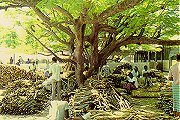

Maldives 
 |
Wood Energy Situation Policies and Programmes Wood Energy Data Further Reading RWEDP Focal Points |
Wood Energy Situation
Woodfuel is the only indigenous and most important source of energy in the country. It is primarily used in the residential sector for cooking. A small amount of fuelwood is also used in the fish processing, palm sugar making and lime making industries. In 1994, total woodfuel consumption was about 1,200 TJ, accounting for 55% of total energy consumption. Fuelwood supply in Male is commercialised. Between 1976 and 1987 the price increased from 1.5 to 5 Rf. per bundle.
Data on the country's wood energy situation is not collected systematically as of yet. Nevertheless, localised fuel shortages that vary quite a lot over the widely scattered islands seem to exist. Similarly, household stove problems are likely to be fairly variable among the islands. Scarcities and unhealthy conditions in rural households need to be addressed. Fuelwood is still widely used, even at Male, but the quality has gone down and the prices have gone up, indicating a shortage of supply.
Policies and Programmes
Apart from government departments there are no specialised institutes or centres for developing fuelwood technologies or wood resources. Surveying energy demand and supply would be a cumbersome undertaking due to the large distances between the many small islands. Linkages are now being established by RWEDP with the Women's Department and NGOs to collect data on wood energy in the country.
Environmental problems related to wood energy may also be serious. The law states that for each tree cut two trees have to be planted, but this can hardly be controlled or implemented effectively. The relatively short-term contracts granted to woodfuel harvesters are also a matter for environmental concern. The contracts used to be for three years but have now been extended to five years. However, RWEDP believes that these short-term contracts are not conducive to proper management. Long-term contracts (e.g. 30 years) may be more effective when it comes to sustainability and environmental protection.
Wood Energy Data
| General | |||||
| Population (1996) | 0.3 mln. | ||||
| Share of Rural Population | 73% | ||||
| GDP per capita (1995) in constant 1987 US$ | 496 | ||||
| Energy Consumption (1993) | |||||
| Total Final Energy Consumption in PJ | 5.3 | ||||
| Consumption of Wood Energy in PJ | 1.2 | (23.0%) | |||
| Consumption of Biomass Energy in PJ | 1.2 | (23.0%) | |||
| Wood Energy Resources | |||||
| Forest Area (1995) in 1000 ha | NA | ||||
| Natural Forest Area (1995) in 1000 ha | NA | ||||
| Agricultural Area (1994) in 1000 ha | 4 | (13.3%) | |||
| Share of Woodfuels from Forest Areas | NA | ||||
| Potential Wood Energy Supply (1994) | |||||
| Sust. Supply from Forest Areas in kton | NA | ||||
| Sust. Supply from Agriculture Areas in kton | 34 | ||||
| Sust. Supply from Other Wooded Land in kton | NA | ||||
| Supply from Wood Waste from Deforestation in kton | NA | ||||
| Total Potential Supply in kton | 34 | ||||
| Primary Wood Energy Requirements in kton | 80 | ||||
Notes:
Population and land use data from FAO (FAOSTAT), GDP per capita from World Bank. Energy consumption data from various sources.
Potential wood energy supply estimated by RWEDP, based on available data for land use, wood productivity and estimates on availability of wood for energy use. For forest land, other wooded land and agriculture areas, the potential supply is based on average annual yield estimates, assuming a sustainable use of resources (Sust.: sustainable). Wood waste from deforestation refers to wood potentially available from natural forest land cleared due to commercial logging, expansion of agriculture land or other reasons. The estimates are based on aggregated national data, which can hide local variations, ranging from scarcity to abundance. For detailed calculations and estimates for 2010, see FD50, chapter 8
Further reading:
| Regional Study on Wood Energy Today and Tomorrow in Asia, Field Document 50, 1997 | |
| Chapter 9 in Review of Wood Energy Data in RWEDP Member Countries, Field Document 47, 1997 |
RWEDP Focal Points in Maldives
Focal points are the main contacts for RWEDP in a member country. Generally, in each country, there is one focal point in the energy sector, and one in the forestry sector.
| Director Agricultural Services Ministry of Fisheries and Agriculture Ghazze Building, Ameer Ahmed Magu Male, 20-05 TEL: 960-322625/323928 FAX: 960-326558 |
Comments, questions? webmaster@rwedp.org
© FAO-RWEDP, 1999